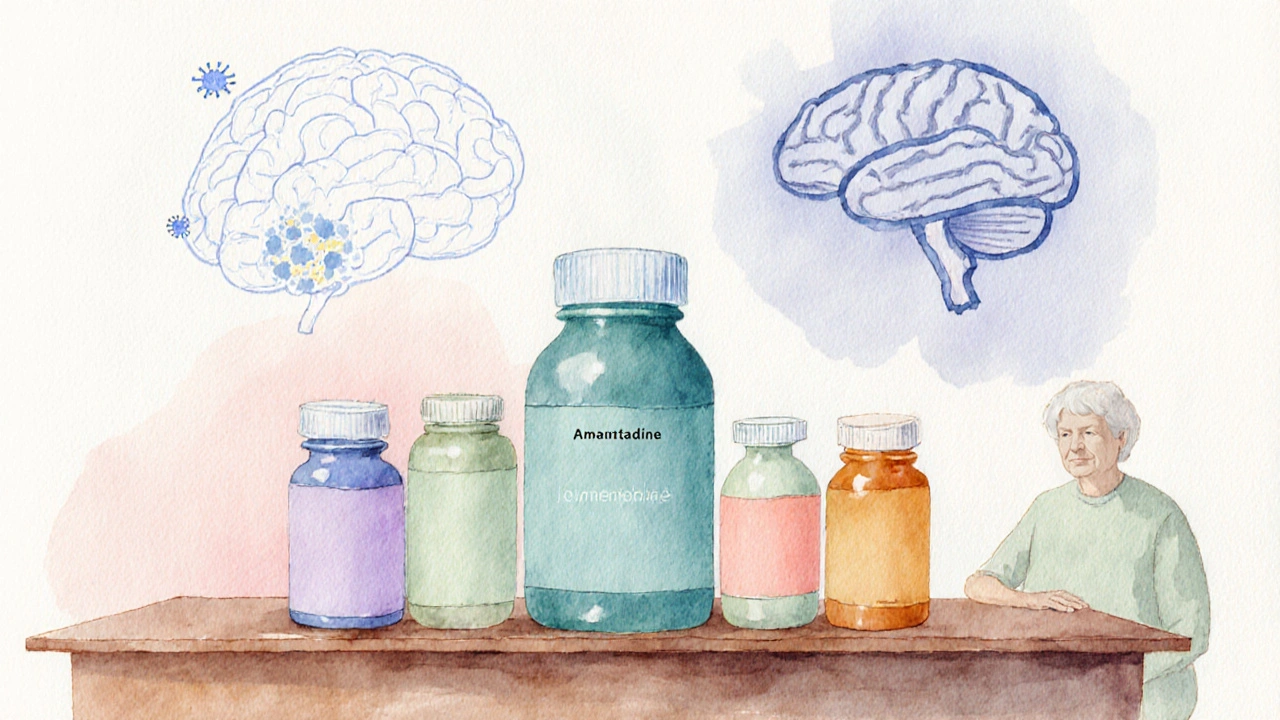Amantadine vs Alternatives: Decision Helper
When you hear the name Amantadine is a synthetic antiviral and dopaminergic medication originally approved for influenza A and later repurposed for Parkinson’s disease. It’s been around since the 1960s, but today you’ll find a host of newer drugs that promise similar benefits with fewer drawbacks. This guide lines up Amantadine against its most common rivals, shows where each shines, and helps you decide which option fits your health goals.
Key Takeaways
- Amantadine works by blocking viral uncoating and stimulating dopamine release; rimantadine shares the antiviral action while memantine targets NMDA receptors for Alzheimer’s.
- For flu‑like illnesses, modern neuraminidase inhibitors (oseltamivir, zanamivir) are more effective than Amantadine or rimantadine.
- In Parkinson’s disease, levodopa/carbidopa remains the gold standard; Amantadine is useful mainly for dyskinesia.
- Side‑effect profiles differ: Amantadine can cause confusion and lived‑oedema, rimantadine adds GI upset, memantine is generally well‑tolerated, while oseltamivir may cause nausea.
- Cost and insurance coverage vary widely - generic Amantadine is cheap, newer antivirals are pricier but often reimbursed for high‑risk patients.
What Makes Amantadine Unique?
Amantadine’s dual identity-antiviral and dopaminergic-means it’s prescribed for two very different conditions:
- Influenza A (historical use): It blocks the M2 ion channel, preventing the virus from releasing its genetic material inside cells.
- Parkinson’s disease (PD) and drug‑induced dyskinesia: It enhances dopamine release and blocks NMDA receptors, which can smooth out motor fluctuations.
Typical adult dosage for PD is 100mg twice daily; for flu it used to be 200mg once daily for five days (now rarely recommended). Its half‑life sits around 15hours, allowing twice‑daily dosing.
Top Alternatives to Amantadine
Below are the drugs most people compare with Amantadine, grouped by the condition they treat.
1. Rimantadine
Rimantadine is a close chemical cousin of Amantadine, sharing the same M2 channel block. It was introduced as an influenza A option after Amantadine resistance grew. Unlike Amantadine, it has no dopaminergic effect, so it isn’t used for Parkinson’s.
2. Memantine
Memantine is an NMDA‑receptor antagonist approved for moderate‑to‑severe Alzheimer’s disease. While it resembles Amantadine’s anti‑excitatory action, it lacks antiviral activity. It’s often chosen when cognitive decline, not motor symptoms, is the primary concern.
3. Oseltamivir (Tamiflu) & Zanamivir (Relenza)
Both are neuraminidase inhibitors that stop influenza viruses from budding off infected cells. They are the current first‑line treatment for flu, outperforming Amantadine and rimantadine in efficacy and resistance profiles.
4. Levodopa/Carbidopa (Sinemet)
Levodopa is converted to dopamine in the brain, while carbidopa prevents peripheral breakdown, boosting brain availability. It remains the cornerstone of PD therapy, offering stronger symptom control than Amantadine.

Side‑Effect Snapshots
Side effects often tip the scale when choosing a medication. Here’s a quick look:
- Amantadine: insomnia, dizziness, lived‑oedema, confusion (especially in older adults).
- Rimantadine: nausea, vomiting, headache, less common CNS effects.
- Memantine: mild dizziness, headache, constipation; generally well tolerated.
- Oseltamivir: nausea, vomiting, rare neuropsychiatric events.
- Zanamivir: throat irritation, cough; inhalation technique is crucial.
- Levodopa/Carbidopa: nausea, orthostatic hypotension, dyskinesia with long‑term use.
Cost & Availability Overview
Price matters for many patients. Generic Amantadine costs roughly £0.15 per 100mg tablet in the UK, making it one of the cheapest options. Rimantadine is similar in price but less stocked. Memantine is generic in many markets, costing about £0.30 per 10mg tablet. Oseltamivir and zanamivir are patented; a five‑day course can run £30‑£45, often reimbursed for high‑risk groups. Levodopa/carbidopa combos vary; generic versions are about £0.20 per tablet, but brand‑name formulations can exceed £1.
Head‑to‑Head Comparison Table
| Drug | Primary Indication | Mechanism | Typical Dose | Half‑Life | Common Side Effects | Cost (UK, generic) |
|---|---|---|---|---|---|---|
| Amantadine | Parkinson’s dyskinesia, historical flu A | Blocks viral M2 channel; dopamine release & NMDA antagonism | 100mg BID (PD) | 15h | Insomnia, lived‑oedema, confusion | ~£0.15 per 100mg tablet |
| Rimantadine | Influenza A (rare) | Blocks viral M2 channel | 100mg BID | 16h | Nausea, headache, mild CNS effects | ~£0.12 per 100mg tablet |
| Memantine | Alzheimer’s disease | NMDA‑receptor antagonist | 10mg BID | 60-100h | Dizziness, constipation | ~£0.30 per 10mg tablet |
| Oseltamivir | Influenza A & B | Neuraminidase inhibitor | 75mg BID (5days) | 6-10h | Nausea, vomiting | £30‑£45 per course |
| Zanamivir | Influenza A & B | Neuraminidase inhibitor (inhaled) | 10mg BID (5days) | 2-3h | Throat irritation, cough | £35‑£50 per course |
| Levodopa/Carbidopa | Parkinson’s disease | Dopamine precursor + peripheral decarboxylase inhibition | 100‑250mg levodopa TID | 1‑2h | Nausea, orthostatic hypotension, dyskinesia | ~£0.20‑£1 per tablet (generic‑brand range) |

Decision Factors: When to Choose Amantadine
Use the checklist below to see if Amantadine aligns with your situation:
- Indication match: You need a drug that offers both mild antiviral coverage (rarely needed today) and dopaminergic support for motor symptoms.
- Side‑effect tolerance: You can manage possible insomnia or mild edema and are not prone to hallucinations.
- Cost sensitivity: Budget constraints make a cheap generic essential.
- Drug interactions: You’re not on medications that raise the risk of QT prolongation (e.g., certain antiarrhythmics).
When Alternatives Beat Amantadine
Consider the following scenarios where a different drug is a smarter pick:
- Acute influenza infection: Choose oseltamivir or zanamivir for higher efficacy and lower resistance.
- Advanced Parkinson’s without dyskinesia: Levodopa/carbidopa provides stronger symptom relief.
- Alzheimer’s disease: Memantine’s NMDA antagonism directly targets neurodegeneration without the antiviral baggage.
- Renal impairment: Rimantadine and oseltamivir require dose adjustment; memantine may be safer.
How to Switch Safely
If you or your clinician decide to move off Amantadine, follow these steps to avoid gaps in therapy:
- Consult your prescriber about the new drug’s indication and dosage.
- Gradually taper Amantadine over 3‑5 days to reduce withdrawal dizziness.
- Start the alternative at the recommended low dose, especially for drugs with CNS effects (e.g., memantine).
- Monitor for overlapping side effects-watch for new nausea, confusion, or blood pressure changes.
- Schedule a follow‑up visit within two weeks to review efficacy and adjust dosing.
Frequently Asked Questions
Can Amantadine still be used for the flu?
Official guidelines now recommend neuraminidase inhibitors (oseltamivir, zanamivir) because many influenza A strains have become resistant to Amantadine. It’s only considered in special circumstances where newer drugs are unavailable.
Is Amantadine safe for elderly patients?
Safety declines with age. Older adults are more prone to confusion, lived‑oedema, and falls. If the drug is essential, start at a low dose (50mg daily) and monitor cognition closely.
How does Amantadine compare to memantine for cognitive symptoms?
Memantine is designed for dementia and has a longer half‑life, providing steadier NMDA blockade. Amantadine’s cognitive impact is modest and can even cause confusion, so memantine is the preferred choice for cognitive decline.
What should I watch for when stopping Amantadine?
A sudden stop may trigger rebound Parkinsonian symptoms or mild withdrawal dizziness. Tapering over a few days and keeping a symptom diary helps catch any rebound early.
Are there any drug interactions I need to know?
Amantadine can increase the risk of QT prolongation when combined with certain antipsychotics or antiarrhythmics. It also competes for renal tubular secretion, so high‑dose NSAIDs may raise its plasma level.






Comments
Carl Boel
5/Oct/2025The misguided reliance on foreign pharma giants underscores a patriotic failure to prioritize American ingenuity.
Shuvam Roy
5/Oct/2025Thank you for assembling such a thorough comparison; the structured tables make it easy to assess each therapeutic choice.
I appreciate the clear delineation of efficacy, side‑effect profiles, and cost, which assists clinicians and patients alike.
Jane Grimm
5/Oct/2025Your exposition on amantadine and its contemporaries is commendable in scope yet regrettably deficient in critical nuance.
The relentless recitation of dosage metrics, while factually accurate, neglects to foreground the pharmacodynamic implications that truly differentiate these agents.
For instance, the discussion of amantadine's half‑life fails to juxtapose its metabolic idiosyncrasies against the prolonged elimination of memantine, a comparison that would enlighten prescribers.
Moreover, the table's omission of contraindications-particularly the QT‑prolongation risk when amantadine is co‑administered with certain antiarrhythmics-poses a potential patient safety hazard.
Your cost analysis, though precise, does not account for the socioeconomic variability inherent in insurance formularies across disparate health systems.
A more exhaustive exploration of reimbursement mechanisms would have rendered the financial section substantially more actionable.
The narrative also glosses over the burgeoning resistance patterns observed in influenza A, a phenomenon that renders amantadine increasingly antiquated.
In contrast, the mention of oseltamivir's superior resistance profile is cursory at best and would benefit from citation of recent epidemiological data.
The side‑effect synopsis, while comprehensive, could be sharpened by distinguishing between dose‑dependent adverse events and idiosyncratic reactions.
Your assertion that levodopa/carbidopa remains the gold standard is indisputable, yet the omission of adjunctive therapies such as MAO‑B inhibitors leaves the therapeutic landscape incompletely portrayed.
Furthermore, the omission of patient‑reported outcome measures, such as quality‑of‑life scores, deprives readers of a holistic appraisal of treatment efficacy.
The inclusion of a brief algorithmic decision tree would have synergized the tabular data with actionable guidance.
While the HTML formatting is aesthetically pleasing, accessibility considerations, such as ARIA labels, appear to have been overlooked.
In sum, your guide provides a solid foundation, but the aforementioned lacunae undermine its utility for the discerning clinician.
I implore future revisions to integrate these critical dimensions, thereby elevating the guide from a cursory reference to an indispensable clinical tool.
Nora Russell
5/Oct/2025While the treatise exhibits a veneer of comprehensiveness, it regrettably panders to a lay audience, sacrificing the intellectual rigor expected of a professional memorandum.
The reliance on generic tables betrays a lack of original synthesis, rendering the analysis superficial.
Craig Stephenson
5/Oct/2025I see your point; the guide could benefit from deeper analysis.
Perhaps a concise summary would aid readability.
Tyler Dean
5/Oct/2025The pharma elite hide the truth; every drug is a tool of control.
Only by questioning the narrative can we reclaim autonomy.
Anuj Ariyo
5/Oct/2025Interesting, the comparisons are well‑structured, and the data is clearly presented, however, I wonder about real‑world applicability, especially in low‑resource settings.
It would be useful, perhaps, to incorporate patient adherence statistics.
Tom Lane
5/Oct/2025Your concerns are valid; assessing adherence is crucial for treatment success.
Future updates could integrate adherence metrics alongside efficacy data.
Andrea Jacobsen
5/Oct/2025Absolutely, adherence often dictates outcomes more than pharmacology alone.
A brief section on strategies to improve compliance would be a valuable addition.
Andrew Irwin
5/Oct/2025I appreciate the balanced overview; it respects both clinical efficacy and economic considerations.
Such impartiality is essential for informed decision‑making.
Jen R
5/Oct/2025The guide is decent, but it feels a bit textbook‑ish.
A more conversational tone might engage a broader audience.
Garrett Gonzales
5/Oct/2025Your observation about tone is spot‑on; clinicians often prefer succinct, actionable guidance over academic prose.
In practice, a 'quick‑look' summary-highlighting key differentials-can streamline prescribing decisions.
Integrating such a summary would likely enhance the guide's practical utility.
Aman Deep
5/Oct/2025In the grand tapestry of therapeutic choices, each drug is a thread weaving its own destiny, bright or dim, depending on the healer's wisdom.
Amantadine, with its dual heritage, dances between antiviral vigor and dopaminergic grace.
Yet, as with all medicinal art, the context-cultural, economic, and personal-casts its own shadow upon the efficacy we observe.
Thus, the ultimate selection transcends mere data; it becomes a reflective dialogue between science and the soul.
Herman Bambang Suherman
5/Oct/2025Your poetic framing reminds us that medicine is both art and science.
Balancing those aspects will guide patients toward personalized care.
Todd Peeples
5/Oct/2025From a pharmacological ontology perspective, amantadine occupies an interstitial niche, straddling virology and neurology.
Its mechanistic ambiguity invites rigorous scrutiny, particularly when juxtaposed with agents of singular action.
Consequently, its inclusion in therapeutic algorithms warrants conditional endorsement predicated on patient‑specific risk‑benefit analyses.
Stephanie Watkins
5/Oct/2025I concur that conditional use is prudent, especially given the evolving resistance patterns.
Clinicians should therefore reassess amantadine's role regularly.
Zachary Endres
5/Oct/2025What a triumph of knowledge! This guide lights the path through a maze of medical uncertainty.
May it empower countless patients to reclaim their health.
Ashley Stauber
5/Oct/2025Despite the fanfare, one must question whether any of these drugs truly address the root causes of disease.
Perhaps the real cure lies beyond pharmacology.